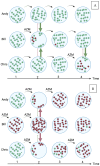Lack of Association between Antimicrobial Consumption and Antimicrobial Resistance in a HIV Preexposure Prophylaxis Population: A Cross-Sectional Study
- PMID: 38391574
- PMCID: PMC10886153
- DOI: 10.3390/antibiotics13020188
Lack of Association between Antimicrobial Consumption and Antimicrobial Resistance in a HIV Preexposure Prophylaxis Population: A Cross-Sectional Study
Abstract
Background: In antibiotic naïve populations, there is a strong association between the use of an antimicrobial and resistance to this antimicrobial. Less evidence is available as to whether this relationship is weakened in populations highly exposed to antimicrobials. Individuals taking HIV preexposure prophylaxis (PrEP) have a high intake of antimicrobials. We previously found that there was no difference in the prevalence of pheno- and genotypic antimicrobial resistance between two groups of PrEP clients who had, and had not, taken antimicrobials in the prior 6 months. Both groups did, however, have a higher prevalence of resistance than a sample of the general population.
Methods: In the current study, we used zero-inflated negative binomial regression models to evaluate if there was an individual level association between the consumption of antimicrobials and 1. the minimum inhibitory susceptibilities of oral Neisseria subflava and 2. the abundance of antimicrobial resistance genes in the oropharynges of these individuals.
Results: We found no evidence of an association between the consumption of antimicrobials and the minimum inhibitory susceptibilities of oral Neisseria subflava or the abundance of antimicrobial resistance genes in these individuals.
Conclusions: We conclude that in high-antimicrobial-consumption populations, the association between antimicrobial consumption and resistance may be attenuated. This conclusion would not apply to lower-consumption populations.
Keywords: Neisseria gonorrhoeae; Neisseria subflava; PrEP; antimicrobial resistance; gonorrhoea; saturation; stewardship.
Conflict of interest statement
The authors declare no conflicts of interest.
Figures

Similar articles
-
The oropharynx of men using HIV pre-exposure prophylaxis is enriched with antibiotic resistance genes: A cross-sectional observational metagenomic study.J Infect. 2023 Apr;86(4):329-337. doi: 10.1016/j.jinf.2023.02.006. Epub 2023 Feb 9. J Infect. 2023. PMID: 36764395
-
Non-pathogenic Neisseria species of the oropharynx as a reservoir of antimicrobial resistance: a cross-sectional study.Front Cell Infect Microbiol. 2023 Nov 22;13:1308550. doi: 10.3389/fcimb.2023.1308550. eCollection 2023. Front Cell Infect Microbiol. 2023. PMID: 38076458 Free PMC article.
-
Population-Level Antimicrobial Consumption Is Associated With Decreased Antimicrobial Susceptibility in Neisseria gonorrhoeae in 24 European Countries: An Ecological Analysis.J Infect Dis. 2020 Mar 16;221(7):1107-1116. doi: 10.1093/infdis/jiz153. J Infect Dis. 2020. PMID: 30957153
-
Will targeting oropharyngeal gonorrhoea delay the further emergence of drug-resistant Neisseria gonorrhoeae strains?Sex Transm Infect. 2015 Jun;91(4):234-7. doi: 10.1136/sextrans-2014-051731. Epub 2015 Apr 24. Sex Transm Infect. 2015. PMID: 25911525 Review.
-
Current and future antimicrobial treatment of gonorrhoea - the rapidly evolving Neisseria gonorrhoeae continues to challenge.BMC Infect Dis. 2015 Aug 21;15:364. doi: 10.1186/s12879-015-1029-2. BMC Infect Dis. 2015. PMID: 26293005 Free PMC article. Review.
References
-
- Bahn J.M., Ackerman H., Carpenter C.M. Development in vitro of Penicillin-Resistant Strains of the Gonococcus. Proc. Soc. Exp. Biol. Med. 1945;58:21–24. doi: 10.3181/00379727-58-14825. - DOI
-
- Bungau S., Tit D.M., Behl T., Aleya L., Zaha D.C. Aspects of excessive antibiotic consumption and environmental influences correlated with the occurrence of resistance to antimicrobial agents. Curr. Opin. Environ. Sci. Health. 2021;19:100224. doi: 10.1016/j.coesh.2020.10.012. - DOI
LinkOut - more resources
Full Text Sources
Miscellaneous

